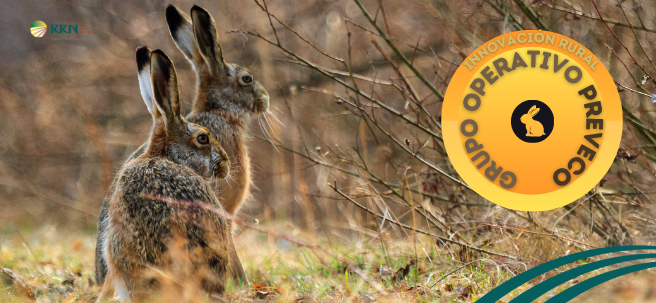
19 de July de 2021
Innovación
July 19, 2021. According to data from Agroseguro, the agricultural insurance company with the largest presence in Spain, rabbits are the wild species that generate the most claims on farms, accounting for more than 40% of claims and affecting an average area of 41,000 hectares annually. Damage caused by rabbits has spread to much of the Iberian Peninsula, affecting several autonomous communities, such as Castilla-La Mancha, Castilla y León, Aragón, Andalusia, Navarra, Madrid, Catalonia, the Valencian Community, and La Rioja.
- The PreveCo Operational Group arose from the need to find innovative solutions for controlling the rabbit population in response to the loss of productivity on farms.
- The research group has just presented its results after a year of research.
With the aim of reducing this damage and making agricultural activity compatible with the proper maintenance and health of this species, the PreveCo project was established in March 2020. The rabbit is a key component of ecosystems, classified by the International Union for Conservation of Nature (IUCN) as endangered, so its management must be approached comprehensively . The solution to the problem of damage and the management and conservation of the species lies not only in preventive measures, but also in improving knowledge of them and addressing actions to improve their populations in low-density areas.
Results
The PreveCo Operational Group was recently closed in June 2021 after just over a year of investigations. The 16 measures implemented by PreveCo have reduced damage by more than 70% , and others have achieved an effectiveness of more than 40% .
Measures with an effectiveness greater than 70% :
- Perimeter fences (81.3%).
- Repellers (75.3%).
- Fences with electric fence and ferret (73.7%).
- Use of organic products that inhibit rabbit attraction to crops (95.8%).
Measures with an effectiveness greater than 40% :
- Perimeter ditches (49.5%).
- Crop transformation (42.9%).
Those responsible for the Operational Group state that "these results indicate that traditionally applied measures, such as ferret control or the installation of fencing, are effective . Meanwhile, more innovative measures, such as the implementation of ultrasonic and sound repellents or the application of an ecological product that acts as an inhibitor, equal or exceed the effectiveness of the above in terms of damage reduction."
They also emphasize that these measures "can be economically viable for farmers, provided they have the support of the authorities, with the implementation and maintenance costs being much lower than the potential economic losses that would result if no preventive measures were taken."
Components of the Operational Group
The PreveCo Operational Group is coordinated by WWF and has the following members: Union of Small Farmers and Ranchers , Fomecam, and CBD-Habitat Foundation . Other collaborating members include Agroseguro, the General Directorate of Sustainability of the Regional Government of Extremadura, and the General Directorate of Natural Environment and Biodiversity of the Regional Government of Castilla-La Mancha. It is 80% co-financed by the European Union, and the authority in charge of managing the application of EAFRD and national aid is the General Directorate of Rural Development, Innovation, and Agri-Food Training (DGDRIFA) of the Ministry of Agriculture, Fisheries, and Food.









